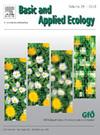Plant and gastropod species richness across fragmented urban landscapes: Patterns and environmental drivers
IF 3.5
2区 环境科学与生态学
Q2 ECOLOGY
引用次数: 0
Abstract
Understanding biota distribution and species richness patterns in fragmented urban environments is crucial for conservation and management.
We surveyed 30 plots in a medium-sized European city to assess vascular plant and terrestrial gastropod species richness in isolated forest patches (IFP), connected forest patches (CFP), and continuous forest (CF), with 10 plots per category. Environmental drivers such as Ellenberg's indicator values, vegetation cover, coarse woody debris, litter, and directly measured microclimatic factors like temperature and humidity were examined.
Significant differences among forest types were found in stand structural characteristics and environmental conditions. IFPs had higher soil pH, more woody debris, and more substantial litter accumulation, with higher temperatures and lower humidity than CF and CFPs, especially in early summer. CF and CFPs mitigated extreme temperatures, leaving IFPs more vulnerable. IFPs had the highest plant species richness, especially neophyte and archaeophyte species, while CF plots had fewer species, mainly of the Carpinion association, indicating more natural conditions. Gastropod species richness and densities were also highest in IFPs. GLMs identified the landscape category as the most significant predictor of species richness for plants and gastropods. Plant species composition varied significantly among forest types, notably for Carpinion and neophytes, whereas gastropod species composition remained consistent.
These findings highlight the complex interplay between environmental factors, urbanisation, and species richness in urban forests. The study underscores the importance of landscape categories, ecological factors, and fragmentation in evaluating species richness patterns in urban and suburban forested areas using plants and gastropods as linked ecological indicators.
碎片化城市景观中的植物和腹足类物种丰富度:模式和环境驱动因素
了解碎片化城市环境中生物群分布和物种丰富度格局对保护和管理具有重要意义。在欧洲某中型城市的30个样地中,以10个样地为单位,对孤立森林斑块(IFP)、连通森林斑块(CFP)和连续森林(CF)中维管植物和陆生腹足类植物的物种丰富度进行了评价。研究了Ellenberg指标值、植被覆盖度、粗木屑、凋落物等环境驱动因子以及温度和湿度等直接测量的小气候因子。不同林型在林分结构特征和环境条件上存在显著差异。与CF和CFPs相比,IFPs土壤pH值更高,木屑较多,凋落物堆积量更大,温度更高,湿度更低,尤其是在初夏。CF和CFPs缓解了极端温度,使IFPs更加脆弱。ifp样地的植物物种丰富度最高,以新生植物和古生植物为主,而CF样地的植物种类较少,以Carpinion类群为主,说明自然条件较多。腹足类物种丰富度和密度在IFPs中最高。GLMs发现景观类别是植物和腹足类物种丰富度的最显著预测因子。不同森林类型的植物种类组成差异显著,尤其是小齿类和新生植物,而腹足类的种类组成基本一致。这些发现强调了环境因素、城市化和城市森林物种丰富度之间复杂的相互作用。该研究强调了景观类型、生态因子和破碎化在以植物和腹足类为关联生态指标评价城市和郊区林区物种丰富度格局中的重要性。
本文章由计算机程序翻译,如有差异,请以英文原文为准。
求助全文
约1分钟内获得全文
求助全文
来源期刊

Basic and Applied Ecology
环境科学-生态学
CiteScore
6.90
自引率
5.30%
发文量
103
审稿时长
10.6 weeks
期刊介绍:
Basic and Applied Ecology provides a forum in which significant advances and ideas can be rapidly communicated to a wide audience. Basic and Applied Ecology publishes original contributions, perspectives and reviews from all areas of basic and applied ecology. Ecologists from all countries are invited to publish ecological research of international interest in its pages. There is no bias with regard to taxon or geographical area.
 求助内容:
求助内容: 应助结果提醒方式:
应助结果提醒方式:


